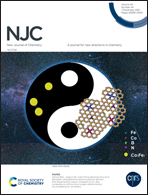Acceptor–donor–acceptor-linked triphenylamine and phenothiazine motifs as cousin molecules: the methyl effect on stimuli-responsiveness, crystallochromism, and dual-state emission†
Abstract
Stimuli-responsive dual-state emitters are in significant demand, although they are hard to achieve. Even though numerous molecules with donor–acceptor–donor (D–A–D) combinations have been investigated, the exploitation of A–D–A systems remains at a nascent stage. Moreover, crystallochromism is a rare but crucial aspect that affects solid-state emission tuning. In this article, we integrate a bulky, conformationally twisted, and electron-rich triphenylamine (TPA) or phenothiazine (PTZ) core into an A–D–A dicyanoaniline (DCA) backbone to attain emissive π-conjugates as small-molecule dual-state emitters (DSEgens). The synthesis of new structurally similar (cousin) molecules is explored judiciously, and this approach provides methylated DCA in triethylamine and nonmethylated DCA through a KOtBu-mediated synthetic pathway. These cousin molecules display disparities in their stimuli-responsive and crystallochromic properties. The influences of methyl and electron-rich bulky groups have created these differences. The methylated/nonmethylated TPADCA pair displays crystallochromic behavior, with similar emission in solution but dramatic differences in solid form, while the PTZ analogs do not exhibit such behavior. In addition, methylated MTPADCA demonstrates 42 nm blue-shifted (green to blue) reversible TFC upon annealing at 180 °C but no fluorescence (FL) switching after grinding. In contrast, TPADCA shows slightly blue-shifted (10 nm) mechanofluorochromic (MFC) behavior only. A crystal-to-crystal transformation, based on slipping in molecular sheets and multiple weak non-covalent interactions, in MTPADCA plays an essential role in creating the thermofluorochromic (TFC) blue-shift compared with TPADCA. Notably, the PTZDCA analogs do not reveal any stimuli-responsive FL switching. The variations in the stimuli-responsive natures of these analogs are interpreted via analyzing molecular conformation data, DFT information, packing motifs, powder/single-crystal X-ray diffraction data, fluorescence lifetime data, and differential scanning calorimetric (DSC) information. Finally, polymer-appended TPADCA and MTPADCA are employed in auto-reversible and self-erasable secure writing platforms.



 Please wait while we load your content...
Please wait while we load your content...